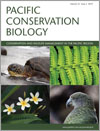
Pacific Conservation Biology
Volume 25 Number 2 2019
PC18020Policy failure and conservation paralysis for the critically endangered swift parrot
Policy and management failings continue to allow logging of breeding habitat for the critically endangered swift parrot. This is occurring despite extensive scientific evidence demonstrating that the cessation of logging of breeding habitat is urgently required. The biggest hurdle to swift parrot conservation is the political will to implement effective conservation plans to secure the species.
PC18020 Abstract | PC18020 Full Text | PC18020PDF (519 KB) | PC18020Supplementary Material (771 KB) Open Access Article
PC18018What to call a dog? A review of the common names for Australian free-ranging dogs
 , A. Gaynor, M. S. Kennedy, C. M. Baudains, P. Adams, P. W. Bateman and P. A. Fleming
, A. Gaynor, M. S. Kennedy, C. M. Baudains, P. Adams, P. W. Bateman and P. A. Fleming
Wildlife elicits human interests, emotions and values often reflected in the use of language to describe species, such as the free-ranging Australian dog. A review of scientific literature demonstrated that a range of factors shaped the use of dingo and wild dog terminology. Common names for free-ranging dogs carry connotations for a diverse range of readers and researchers.
PC18037Low endemic bee diversity and very wide host range in lowland Fiji: support for the pollinator super-generalist hypothesis in island biogeography
 and Michael P. Schwarz
and Michael P. Schwarz
We explore floral host breadth in an endemic Fijian bee and compare it to four introduced species. Homalictus fijiensis is the only native bee in Fiji at elevations lower than 800 m asl. We found that H. fijiensis is a super-generalist and that this may make Fiji vulnerable to exotic weeds.
PC18039Identifying avian indicators of elevation in the Gondwanan rainforests of Australia
The birds of Australia’s eastern rainforests are largely confined to mountain ranges, making them vulnerable to climate-change-driven changes in these ecosystems. We identify avian indicators of elevation that are suitable for the long-term monitoring of climate change effects. The approach described in this paper may lead to more efficient climate change monitoring, and help inform conservation programs.
Sudest and surrounding islands of the Louisiade Archipelago (Papua New Guinea) support high levels of endemism. Subsistence agriculture remains the primary driver of forest loss on these islands. We assessed the relationship between this agricultural practise and forest loss since 1974, finding forest on Sudest Island to be relatively secure.
The advent of light GPS tags has revolutionised our ability to gather real-time data on foraging location and behaviour of seabirds. Here we assess the utility of common noddies as indicators of ocean productivity with specific reference to the application of these types of data in the design of marine reserves in the East Indian Ocean.
The breeding chronology of Germain’s swiftlets (Aerodramus inexpectatus germani) was determined and related to prey availability. Our findings indicating that breeding period varies between different sites results from variation in food supply that is, in turn, influenced by rainfall. The swiftlets appear to adjust their strategies to meet with food peaks.
Cranes forage amongst crops on the Atherton Tablelands. The relationship between cranes and farmers is critical to their conservation, as they can cause damage to crops. We found that most farmers tolerated cranes but agronomic trends may reduce foraging opportunities and increase the potential for damage and conflict with farmers.
Sixty-three butterfly species have been recorded from the Pilliga Forest on the western slopes of the Great Dividing Range in northern New South Wales. This is one of the richest recorded butterfly faunas of any location on the New South Wales western slopes and adjacent plains and highlights the significant conservation value of the Pilliga Forest in the predominantly cleared western slopes bioregions.
PC18034Evidence of a biomass hotspot for targeted fish species within Namena Marine Reserve, Fiji
Marine reserves can be an effective tool to conserve fish biodiversity in regions with poorly regulated fisheries. We report findings from a census within Namena, Fiji’s oldest and second largest marine reserve, revealing remarkably high diversity, abundance and biomass of targeted fish species comparable to estimates from historically unfished reefs.
This note deals with the levels of awareness and interpretations of the term ‘biodiversity’. We describe a representative and substantial sample, and modest levels of interpretability. We also explore variation in whether or not people have an interpretation with education, income and sex. Our results highlight the difficulty associated with using the term ‘biodiversity’ when engaging the general public.
The impacts of tropical cyclones combined with a marine heatwave are reported for a seagrass community at Ningaloo Reef, Western Australia. A community of 9.5 ha of Amphibolis antarctica was lost following a combination of cyclone-induced burial and a marine heatwave. No new seedlings have been observed since the loss; recruitment of seedlings may be impeded by local ocean circulation.
The Phoenix Islands Protected Area is in a naturally iron-poor region in the equatorial central Pacific. The introduction of iron to this environment from shipwrecks is linked to proliferation of turf algae and cyanobacterial mats, and the formation of degraded ‘black reefs’. No recovery has been documented at black reefs observed between 2003 and 2015.



